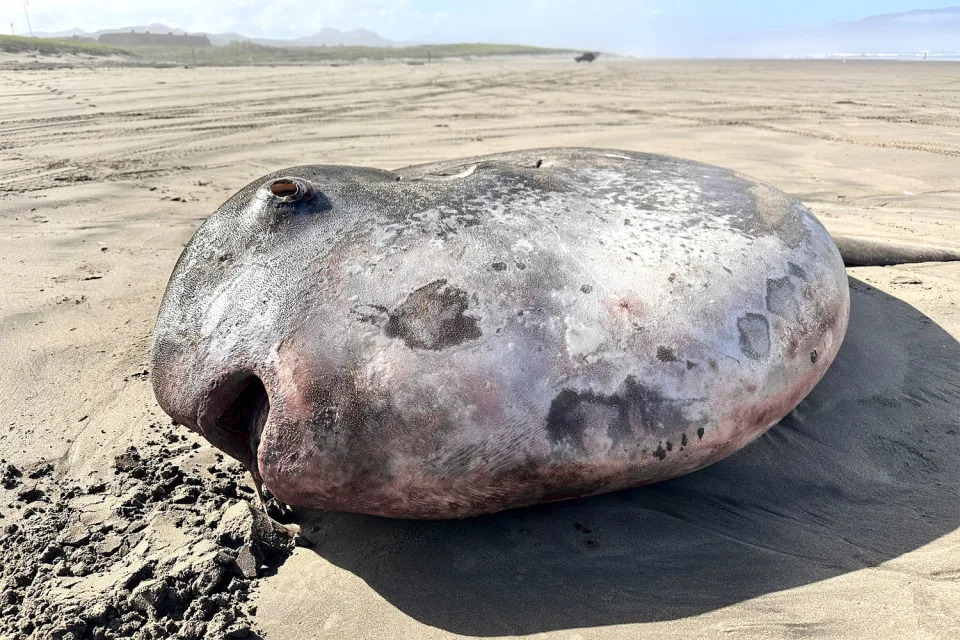A giant 'sunbathing' fish that washed ashore in Oregon turned out to be an unexpected oddity
Elysee Barakett
Updated Wed, June 12, 2024
A giant species of fish that was first discovered seven years ago washed ashore in Oregon last week, according to marine biologists who study the animal.
Beachgoers in Gearhart, a small town just south of the Washington border, found the 7.3-foot-long hoodwinker sunfish, also called a mola tecta, on June 3.
The species was first discovered in 2017 and has been occasionally spotted near Australia, New Zealand and the Pacific Northwest. It’s recognizable by a thick flap of skin in place of a tail, which is split in two.
When Keith Chambers, the general manager at Seaside Aquarium in Oregon, first received reports of a circular, gray fish on the beach, he assumed it was a run-of-the-mill ocean sunfish.
“I’ve seen a lot of them,” he said. “It wasn’t that spectacular of a moment for me.”
But marine biologist Marianne Nyegaard noticed something unique in the aquarium’s Facebook photo showcasing their finding — the fish had smooth skin and a two-part tail. She identified the fish as a mola tecta, a species she discovered and has been researching since.
“As soon as we could, we just jumped in the car and drove down to see it,” Nyegaard, who lives in New Zealand but was fortuitously visiting Seattle that weekend, said.
“It was a fantastic coincidence. It doesn’t get any better than that,” she said.
“It’s like I can’t get away from them,” she added, laughing.

newly discovered and rare species of sunfish (Courtesy Seaside Aquarium)
The name “mola” comes from Latin and means “millstone,” which refers to the fish’s flat and circular body. The fish are known for floating along the ocean’s surface — what some scientists lightheartedly refer to as “sunbathing.”
But Nyegaard said the activity serves an important purpose: catching jellyfish and other gelatinous creatures for prey.
Sunfish dive deep down into colder water when they hunt. Since their bodies cannot efficiently regulate temperature, they warm themselves using the sun. While the fish lie on the ocean’s surface, birds clean them by eating parasites off their skin.
Certain features of hoodwinker sunfish distinguish them from ocean sunfish, Nyegaard said. As ocean sunfish grow, their skin wrinkles. Hoodwinker sunfish are always completely smooth.
Where a normal fish would have a tail, sunfish have a flap. An ocean sunfish’s flap is wavy and has bony formations. The hoodwinker sunfish’s flap is divided into two, and it can move each part independently of the other.
“Why those two species need different backends, we don’t know,” Nyegaard said. Some theories are that they need the two-part flap for steering or agility, she said.
Nyegaard said sunfish in general are still mysterious to scientists. There are five species in total, including the hoodwinker, but it’s unclear how or whether they can co-exist in the same location.
It’s also unclear whether the hoodwinker fish in Australia and New Zealand are linked to the ones in the Pacific Northwest and have somehow migrated across the equator, Nyegaard said.
Since the discovery, people have flocked to Gearhart Beach to visit the lone hoodwinker on the sand.
“It’s not the first time it’s washed up, but it is the largest one to wash up,” said Tierney Thys, a marine biologist at California Academy of Sciences.
“Strandings like this remind us how humans inhabit a mere 1% of the available living space on this vast ocean planet,” she said. “It’s both humbling and inspiring to encounter one of these incredible creatures and a powerful reminder we have so much more to learn.”
CORRECTION (June 12, 2:22 p.m. ET): A previous version of this article misstated what Mola means in Latin. It is millstone, not milestone. It also misspelled the first name of the marine biologist at California Academy of Sciences. She is Tierney Thys, not Tierny.
This article was originally published on NBCNews.com
No comments:
Post a Comment